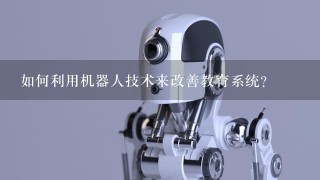如何利用机器人技术来改善教育系统?

1. personalize learning:
- Robots can track students' progress and identify areas where they need additional support.
- They can provide personalized learning experiences tailored to each student's needs.
2. adaptive learning:
- Robots can adjust the pace and difficulty of lessons based on students' progress.
- This ensures that students are challenged and supported at the appropriate level.
3. virtual reality and simulations:
- Robots can create immersive learning experiences that allow students to explore real-world scenarios.
- This can enhance their understanding and problem-solving skills.
4. personalized feedback:
- Robots can provide students with real-time feedback on their performance.
- This helps students identify areas where they need improvement and track their progress over time.
5. 24/7 access to learning resources:
- Robots can provide students with access to learning resources 24/7, regardless of their location.
- This can increase student engagement and motivation.
6. teacher support:
- Robots can assist teachers by automating tasks such as grading, providing feedback, and creating lesson plans.
- This allows teachers to focus on more important tasks, such as interacting with students and providing guidance.
7. assessment and evaluation:
- Robots can be used to automate assessments and provide students with immediate feedback on their performance.
- This can help teachers identify areas where students need additional support and track their progress over time.
8. accessibility:
- Robots can provide educational opportunities to students with disabilities or learning differences.
- They can offer alternative formats of instruction and provide personalized support.
9. cost-effectiveness:
- Robots can automate tasks and reduce the need for expensive human resources.
- This can make education more accessible to students who may not otherwise be able to afford it.
10. creativity and innovation:
- Robots can be used to create engaging and interactive learning experiences that go beyond traditional classroom settings.
- This can foster creativity and innovation in students.

















































